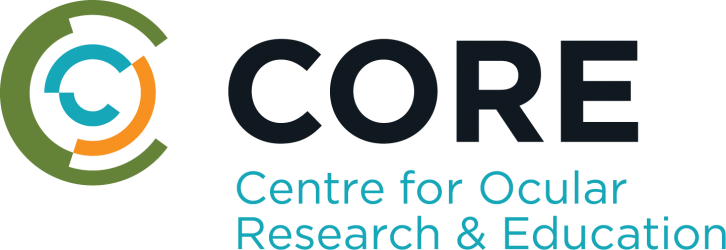Publications
Showing 25 results out of 581 in total.
Simpson,T. L., Situ,P., Jones,L. W., Fonn,D.
Dry eye symptoms assessed by four questionnaires
Optometry and Vision Science 2008;85(8):E692-E699 [ Show Abstract ]
PURPOSE.: To establish the relationships between commonly used questionnaires including Dry Eye Questionnaire, McMonnies Questionnaire, and Ocular Surface Disease Index, and to test the construct and face validity of the simple Subjective Evaluation of Symptom of Dryness. METHODS.: Ninety-seven non-contact lens wearing subjects were enrolled in the study and classified into either a "dry" and "non-dry" group using a single score from an initially applied subjective evaluation of symptom of dryness. The four questionnaires were then completed in a random order. The unidimensionality and accuracy of the responses was assessed using Rasch and receiver (or relative) operating characteristics curve analysis and the characteristics of and association between symptoms were compared using non-parametric statistics. RESULTS.: The responses from the Dry Eye Questionnaire, McMonnies Questionnaire, and Ocular Surface Disease Index met the Rasch analysis criterion of unidimensionality. Each test separated the symptomatic and asymptomatic groups well [all receiver (or relative) operating characteristics area-under-the-curve statistics at least 0.88] and there were significant associations between the results from each questionnaire (all Spearman ρ at least 0.64). CONCLUSIONS.: The results illustrate that different questionnaire-based instruments examining symptoms in controls and symptomatic subjects derive unidimensional data that are similar inasmuch as the overall scores are highly correlated. The data also point to the utility of a quick, three-question screening tool in dry eye research. © 2008 American Academy of Optometry.
Simpson,T., Fonn,D.
Optical coherence tomography of the anterior segment
Ocular Surface 2008;6(3):117-127 [ Show Abstract ]
Perhaps no diagnostic technology has emerged as rapidly in ophthalmology as optical coherence tomography (OCT). A single clinical device for this noninvasive imaging technique was first released in 1996, and now at least ten clinical devices are available. Although the first clinical anterior segment OCT was marketed only 2 years ago, a substantial amount of work has been done using modified retinal imagers or prototype laboratory-based imagers. In this review, we discuss OCT imaging primarily of the cornea. We also highlight previous and current publications on nonclinical and clinical uses of the device to illustrate how anterior segment OCT can be used to understand corneal structure and function in health and disease. © 2008 Ethis Communications, Inc.
Sin,S., Simpson,T. L.
The repeatability of corneal and corneal epithelial thickness measurements using optical coherence tomography
Optometry and Vision Science 2006;83(6):360-365 [ Show Abstract ]
PURPOSE.: The purpose of this study is to examine within and between session repeatability of clinical optical coherence tomography (OCT) imaging for anterior segment morphometry. METHODS.: Images of the corneal apex of each eye in 18 subjects were obtained using a Humphrey Zeiss OCT imager. Subjects viewed a target positioned to ensure that scans were orthogonal to the ocular surface and each image, consisting of 100 adjacent sagittal scans, analyzed using custom software. Repeatability data were analyzed using intraclass correlation coefficients (ICCs), correlation coefficient of concordance (CCC, perfect test-retest agreement ICC or CCC = 1.0), and coefficients of repeatability (COR, 95% confidence interval of test-retest differences). To account for each eye, the multivariate repeatability statistic Iota was estimated. RESULTS.: Mean central corneal and epithelial thickness of 32 eyes (OD and OS combined) is 536 ± 26 μm (standard deviation [SD]) and 52 ± 3 μm (SD) with 5th and 95th percentile thicknesses of 507 and 591 μm for central cornea and 48 and 57 μm for central epithelial. Worst case within session repeatability was defined as repeatability between images with greatest differences in mean thickness within a session. Corneal thickness worst case ICC was 0.95 and COR was ± 9.98 μm. Epithelium worst case ICC was 0.36, CCC was 0.12, and COR was ± 11.11 μm. First image between session corneal thickness had an ICC = 0.98 and a COR = 10.83 μm, whereas epithelium ICC = 0.38, CCC = 0.37, and COR was ± 12.84 μm. When we compared the average of the first three tests with the first three retest images, corneal ICC was 0.98 and COR was ± 10.64 μm and epithelium ICC = 0.73, CCC = 0.72, and COR was ± 6.53 μm. Iota (multivariate repeatability, using eye as a factor) for the cornea was at least 0.96 (worst case) and increased to at least 0.98 when within-session image data were averaged. Iota for epithelium measures ranged from 0.29 when first images were compared with 0.57 when within-session image data were averaged. CONCLUSIONS.: There is very good repeatability of corneal thickness measurement using OCT; even the worst case measurements are similar between sessions. On the other hand, this is not the case for epithelium measurements, and if multiple images within a session are acquired, the worst case results demonstrate how important it is to optimize each OCT scan and also average multiple scans to maximize intersession repeatability. Copyright © 2006 American Academy of Optometry.
Situ,P., Du Toit,R., Fonn,D., Simpson,T.
Successful monovision contact lens wearers refitted with bifocal contact lenses
Eye and Contact Lens 2003;29(3):181-184 [ Show Abstract ]
Purpose. Should successful monovision contact lens wearers be refitted with bifocal lenses? Methods. Fifty current monovision lens wearers were fitted with ACUVUE Bifocal contact lenses (Johnson & Johnson Vision Care, Jacksonville, FL). Visual function and subjective vision ratings were assessed with habitual monovision lenses at the first visit and then were repeated at the end of 6 months while wearing bifocal lenses. Lens preference was determined at the end of the 6-month study, and the subjects were called 1 year later to repeat the lens preference questionnaire. Results. Forty (80%) subjects completed the 6-month study; nine discontinued for visual reasons. At the end of 6 months of wear, 68% preferred bifocal lenses and 25% preferred monovision. Of the subjects who were contacted a year later, 53% were still wearing bifocal lenses. High-contrast visual acuity and letter contrast sensitivity at distance was the same for monovision and bifocal lenses, but low-contrast acuity was better with monovision. Intermediate low- and high-contrast acuity and 3-meter and near stereoscopic acuity were better with bifocal lenses. Near high- and low-contrast acuity were better with monovision. All subjective ratings, except near vision in poor lighting, were significantly greater with bifocal lenses. Conclusions. It is possible to refit successful monovision lens wearers with simultaneous vision bifocal lenses, and these lenses should be considered as an alternative method for the correction of presbyopia. In addition, subjective responses to bifocal lenses may not be reflective of visual function measurements. © 2003 Contact Lens Association of Ophthalmologists, Inc.
Situ,P., Elliott,D. B.
The detection of change in stereoacuity
Chinese Journal of Optometry and Ophthalmology 2000;2(4):216-218 [ Show Abstract ]
Objective: To compare the repeatability of the Frisby, Randot and Howard-Dolman stereotests, and to determine the 95% confidence limits for the change of each test. Methods: Stereoacuity using the three clinical stereoacuity tests was measured in 26 healthy adult subjects with normal binocular vision. The subjects were retested approximately one week later. Results: The coefficients of repeatability for the three tests were ±2.7" (Frisby) ±8.0" (Randot) and ±9.3" (Howard-Dolman) and test-retest correlation coefficients were 0.91 (Frisby), 0.56 (Randot), and 0.60 (Howard-Dolman). Conclusion: The Frisby test showed the best repeatability and smallest range of normal values. For young adults, the 95% confidence limits for change were calculated to be ±2.7". If a young adult's stereoacuity measured with the Frisby test changes by more than this amount, then this should be considered a significant clinical change.
Situ,P., Simpson,T. L.
Interaction of corneal nociceptive stimulation and lacrimal secretion
Investigative Ophthalmology and Visual Science 2010;51(11):5640-5645
Situ,P., Simpson,T. L., Fonn,D.
Eccentric variation of corneal sensitivity to pneumatic stimulation at different temperatures and with CO2
Experimental eye research 2007;85(3):400-405 [ Show Abstract ]
The purpose was to measure corneal sensitivity at multiple corneal positions using pneumatic stimuli, at room temperature and at ocular surface temperature (with and without CO2 added), in 15 healthy participants. Sensitivity of central, mid-peripheral, and peripheral cornea was measured using a computer-controlled modified Belmonte esthesiometer to deliver pneumatic cool (air at 20 °C), mechanical (air at 50 °C), and chemical stimuli (air at 50 °C with CO2 added). The ascending method of limits and method of constant stimuli were adopted to determine the threshold to these stimuli at each location. Sensitivity across the cornea using pneumatic stimuli at different temperatures and chemical stimuli varied only slightly. These patterns of variation are different to what has been previously reported using Cochet-Bonnet esthesiometry. © 2007 Elsevier Ltd. All rights reserved.
Situ,P., Simpson,T. L., Fonn,D., Jones,L. W.
Conjunctival and corneal pneumatic sensitivity is associated with signs and symptoms of ocular dryness
Investigative Ophthalmology and Visual Science 2008;49(7):2971-2976 [ Show Abstract ]
PURPOSE: To investigate the relationships of dry eye symptoms and corneal and conjunctival sensitivity to pneumatic stimulation, tear film stability, and clinical ocular surface characteristics in symptomatic and asymptomatic subjects. METHODS: Ninety-seven subjects were enrolled and grouped by a questionnaire-based single score for symptoms of ocular dryness (none to trace, non-dry group; mild to severe, symptomatic group); 43 were symptomatic and 54 were non-dry. Corneal (K) and conjunctival (C) sensitivities were measured with a computer-controlled Belmonte pneumatic (room temperature) stimulus. Symptoms were assessed according to the Ocular Surface Disease Index (OSDI). Ocular surface staining with fluorescein (FL) and lissamine green (LG), noninvasive tear film break-up time (NIBUT), and the phenol red thread test (PRT) were assessed. RESULTS: The symptomatic group showed lower K and C thresholds (P < 0.01), greater corneal FL and conjunctival LG staining, and shorter NIBUT than did the non-dry eye group (all others P < 0.05). The OSDI scores were higher in the symptomatic group (P < 0.001). K and C thresholds and NIBUT were inversely correlated with the OSDI and corneal and conjunctival staining (all P < 0.05). The K and C threshold and NIBUT (all P < 0.01) correlated positively. Step-wise multiple regression analysis showed that ocular surface sensitivity and NIBUT were significant predictors of the OSDI. CONCLUSIONS: Ocular irritation assessed with the OSDI is associated with ocular surface hyperesthesia to cooling, corneal epitheliopathy, and tear film instability. Although cause and effect are unclear, the analysis showed that altered corneal and conjunctival sensory processing and tear film attributes are essential aspects of what characterizes dry eye.
Situ,P., Simpson,T. L., Jones,L. W., Fonn,D.
Conjunctival and corneal hyperesthesia in subjects with dryness symptoms
Optometry and Vision Science 2008;85(9):867-872 [ Show Abstract ]
PURPOSE.: To compare conjunctival and corneal sensitivity in noncontact lens wearing subjects with and without symptoms of ocular dryness, stratified by age and gender. METHODS.: Ninety-seven subjects were enrolled, 54 of whom were asymptomatic and 43 of whom were symptomatic of ocular dryness. A single score for the symptom of dryness was used to classify nondry eye (scores of none to trace) and dry eye symptomatic (scores of mild to severe) groups. The subjects were further stratified into "younger" (19 to 49 years) and "older" age groups (50 to 80 years). Conjunctival and corneal sensitivity of the right eye was measured at the central cornea and temporal conjunctiva, using a computer-controlled pneumatic esthesiometer with stimulus temperature set at 20°C. The ascending method of limits was used to determine the thresholds. RESULTS.: Conjunctival and corneal thresholds were significantly lower in the dry eye symptomatic than in the nondry eye group (both p 0.05). Conjunctival threshold in the nondry eye women was lower than the men (p 0.05). CONCLUSIONS.: Conjunctival and corneal sensitivity to pneumatic cool stimulation is increased in subjects with symptoms of ocular dryness. This hyperesthesia seems to be more significant in the conjunctiva. © 2008 American Academy of Optometry.
Situ,P., Simpson,T. L., Jones,L. W., Fonn,D.
Effects of silicone hydrogel contact lens wear on ocular surface sensitivity to tactile, pneumatic mechanical, and chemical stimulation
Investigative Ophthalmology and Visual Science 2010;51(12):6111-6117 [ Show Abstract ]
PURPOSE. To determine the effects of silicone hydrogel lens wear and lens-solution interactions on ocular surface sensitivity. METHODS. Forty-eight adapted lens wearers completed the study, which comprised two phases. Phase 1 included habitual lens wear, no lens wear (7 ± 3 days), and balafilcon A lenses (PV; PureVision; Bausch & Lomb, Rochester, NY) with a hydrogen peroxide-based regimen for 2 weeks; phase 2 included wear of PV with the use of a multipurpose solution containing either polyhexamethylene-biguanide (PHMB) or Polyquad/Aldox (Alcon Laboratories, Fort Worth, TX) preservative, each for 1 week, with a 2-week washout period between solutions. Tactile and pneumatic (mechanical and chemical) stimuli were delivered, and thresholds were determined by Cochet-Bonnet (Luneau Ophthalmologie, Chartres, France) and Belmonte (Cooperative Research Centre for Eye Research and Technology, Sydney, NSW, Australia) pneumatic esthesiometers, respectively. Corneal and conjunctival thresholds and staining scores were assessed at baseline, after 2 and 8 hours of lens wear on day 1 and at the end of each wearing cycle (2 hours). RESULTS. In phase 1, compared to the no-lens baseline, corneal tactile thresholds increased at the 1-day, 8-hour and the 2-week visits (P < 0.05), whereas conjunctival mechanical thresholds decreased at the 1-day, 2-hour and the 2-week visits (P < 0.05). In phase 2, the chemical thresholds were lower with PHMBpreserved solution compared with the Polyquad/Aldox system at the 1-day, 2-hour and the 1-week visits (P < 0.05). Staining scores correlated inversely with conjunctival chemical thresholds (all P < 0.05). CONCLUSIONS. Ocular surface sensitivity changed in adapted lens wearers, when lenses were refit after a no-lens interval and during lens wear with different care regimens. The corneal staining that was observed with certain lens-solution combinations was accompanied by sensory alteration of the ocular surface-that is, higher levels of staining correlated with increased conjunctival chemical sensitivity. © Association for Research in Vision and Ophthalmology.
Sivak,J. G., Herbert,K. L., Fonn,D.
In vitro ocular irritancy measure of four contact lens solutions: Damage and recovery
CLAO Journal 1995;21(3):169-174 [ Show Abstract ]
We measured the potential toxicity of four contact lens solutions using an in vitro approach in which the optical quality of the cultured bovine lens was measured as a function of exposure to each substance tested. This approach uses an automated scanning laser to measure the focal variability of lenses contained in special culture cells and maintained under long-term culture conditions. The products tested included three rigid gas permeable contact lens conditioning solutions (Boston Conditioning Solution(TM), Boston Advance Conditioning Solution(TM), and a new formulation of Boston Advance Conditioning Solution(TM) [Polymer Technology]) and one soft contact lens disinfecting system (OptimEyes(TM); Core Technologies). The results indicate a wide range of toxicologic potential that corresponds, on a relative basis, with published in vivo evaluation of the same substances. Moreover, the results demonstrate that this in vitro system can be used to evaluate the potential for recovery from damage caused by the four solutions tested.
Skaff,A., Cullen,A. P., Doughty,M. J., Fonn,D.
Corneal swelling and recovery following wear of thick hydrogel contact lenses in insulin-dependent diabetics
Ophthalmic and Physiological Optics 1995;15(4):287-297 [ Show Abstract ]
Thick, 0.34 mm, 38% water hydrogel lenses were fitted, under a pressure patch, to one eye of 18 type I diabetic patients (aged 18-40 years) to assess the acute response to hypoxia and hypercapnia; the response was compared with that in 18 healthy, aged-matched nondiabetic subjects; the closed-eye lens wear was started mid-morning. Pre-lens wear assessments were made of acuity, intraocular pressure (IOP), central corneal thickness (CCT) and corneal appearance by biomicroscopy. The mean duration of the diabetes was 13±7 years and the Baseline CCT values were marginally greater in diabetic patients (600±33μm) compared with a group of non-diabetic control subjects (584±26μm; P>0.5). A 7.7±2.1% increase in CCT was measured after 3h lens wear in the diabetic patients while an average 10.6±2.4% increase in CCT was measured in the control subjects (P<0.05). The recovery of corneal thickness to baseline values in diabetic patients was slower (at 44.8±2.0% per hour) than the control subjects (53.9±2.1 per hour; P<0.05) although recovery of corneal thickness occurred in both groups within 2.5-3h, IOP values (non-contact tonometry) were higher in the diabetic patients than in the controls (14.5±2.9 vs 12.4±1.7mmHg; P<0.01). Overall, those corneas with greater baseline CCT values tended to swell less than those with lower baseline CCT values (r = 0.582). Positive correlations were also found between corneal thickness and IOP and blood glucose. The diabetic patients thus tended to have slightly thicker corneas (but this could be related to blood glucose or IOP rather than true corneal disease) and also had corneas that tended to swell less with a contact lens stress test (but this could be constitutively due to the slight oedema already present). The different corneal response in diabetic patients may thus be the result of physical determinants such as initial oedema and IOP and not the result of a disease of the cornea itself.
Sorbara,L., Chong,T., Fonn,D.
Visual acuity, lens flexure, and residual astigmatism of keratoconic eyes as a function of back optic zone radius of rigid lenses
Contact Lens and Anterior Eye 2000;23(2):48-52 [ Show Abstract ]
The purpose of this study was to determine whether the visual acuity of keratoconic eyes was affected by alteration of back optic zone radii (BOZRs) of rigid gas permeable lenses (RGP) contact lenses. Visual acuity, spherical and sphero-cylindrical over-refraction and keratometry of the front surface of the RGP lenses of nine keratoconic eyes were measured. The BOZR of the five lenses varied from steeper to flatter than that habitually worn by the subjects. The steepest lenses produced significantly greater lens flexure and residual astigmatism (P<0.002) and worse high and low contrast visual acuity with the spherical over-refraction (P<0.05). There was no statistical difference in visual acuity across the range of BOZR when a sphero-cylindrical over-refraction was applied. Thus reduced visual acuity in keratoconus with steep lenses is likely due to uncorrected residual astigmatism from a combination of several possible sources. © 2000 British Contact Lens Association.
Sorbara,L., Dalton,K.
The use of video-keratoscopy in predicting contact lens parameters for keratoconic fitting
Contact Lens and Anterior Eye 2010;33(3):112-118
Sorbara,L., Fonn,D., Holden,B. A., Wong,R.
Centrally fitted versus upper lid-attached rigid gas permeable lenses. Part I. Design parameters affecting vertical decentration
International Contact Lens Clinic 1996;23(3):99-104 [ Show Abstract ]
The purpose of this study was to develop rigid gas permeable lens designs that would facilitate upper lid attachment and central (interpalpebral) positions. A pilot study was conducted with trial lenses of varying back surface designs and axial edge lifts (AELs) with and without lenticulated front surface designs. From this study, the final upper lid attachment lens was designed to have high AELs (150–300 mm) and a minus carrier lenticulation. The centered lenses had an AEL of 110 mm, with thin edges. Forty-one neophyte subjects were fitted with these two designs to be worn contralaterally for an 8-month period during which the consistency of the lens position was examined. We were unable to achieve upper lid attachment on 6 subjects, and a further 10 were discontinued for other reasons. Of the remaining 25 subjects who completed the study, 80% had consistent upper lid attachment in the one eye and a centered lens in the other, over the eight visits. The balance of the subjects demonstrated correct lens positioning for at least 50% of the visits. The lens design factors that correlated with vertical decentration of the lenses were AEL (r = 0.614), edge thickness (r = 0.751), and front surface carrier radius (r = 0.654).
Sorbara,L., Fonn,D., MacNeill,K.
Effect of rigid gas permeable lens flexure on vision
Optometry and Vision Science 1992;69(12):953-958 [ Show Abstract ]
The flexure of spherical rigid lenses (various materials) and a soft lens was measured using automated over-keratometry on 6 adapted rigid lens wearers (12 eyes) whose corneal toricity ranged from 1.37 to 3.87 D. The results showed: (1) that there was no significant difference in flexure between polymethyl methacrylate (PMMA), silicone acrylate, and the fluorosilicone acrylate lenses (whose Dks ranged from 0 to 115). However, Advent (fluoropolymer) did flex significantly more than the other rigid lenses, and significantly less than the soft lens (Bausch & Lomb U4) and (2) that lens flexure of the rigid lenses did not alter over a 2-h period. We also measured high and low contrast visual acuity (HCVA and LCVA), and the results from subjects wearing Advent and the soft lens were significantly worse than with the other rigid lenses. Finally, the results of this study showed no correlation between rigid lens flexure and permeability and between rigid lens flexure and visual acuity when Advent was excluded from the linear regression analysis.
Sorbara,L., Fonn,D., Simpson,T., Lu,F., Kort,R.
Reduction of myopia from corneal refractive therapy
Optometry and Vision Science 2005;82(6):512-518 [ Show Abstract ]
Purpose. The purpose of the study was to monitor the efficacy of corneal refractive therapy (CRT) lenses to reduce myopia over a 4-week period. Refractive error, keratometry, high and low contrast acuity, and subjective vision after 28 days of using CRT contact lenses were measured. Methods. Twenty-three myopes wore CRT HDS lenses, Dk = 100. The Nikon autokefractor/keratometer was used to measure the refractive error and keratometric changes. Visual acuity was measured using computerized high and low contrast charts and the subjects completed visual analog scales characterizing their vision on a daily basis. Measurements were performed at baseline (before lens insertion before sleep), immediately after lens removal the next morning and at 1, 3, 7, and 14 hours after eye opening. Measurements were made on the days following 1, 4, 10, and 28 nights of lens wear. After 72 hours of no lens wear, these parameters were again measured to assess corneal recovery. Results. The pretreatment manifest refraction (mean of OD and OS ± standard deviation [SD]) was -2.72 DS ± 1.06 and -0.55 DC ± 0.40. Myopic spherical equivalent refractive error (± SD) decreased by 1.30 DS ± 0.53 (range 0-3 D) immediately after lens removal on day 1 and by 2.59 DS ± 0.77 by day 28 (range 1.25-3.88 D). The cylinder remained unchanged. Uncorrected visual acuity improved by 5 lines after one night and reached 0.00 LogMAR (6/6) by day 4. Visual acuity was maintained throughout the day by day 10. The day and time effect of the spherical equivalent change and the central corneal radius of curvature were statistically significant (p < 0.01) up to day 10 and remained the same until day 28. Central (autokeratometer) Ks flattened by 1.28 D ± 1.35 after one night and 2.33 D ± 1.30 by day 28. The subjective vision improved significantly from day 1 to day 28 (p < 0.01) and was maintained throughout the day from day 4 to day 28 (p < 0.01). All measures did not recover completely to baseline after 72 hours of no lens wear. Conclusions. CRT lenses significantly reduced myopia, improved visual acuity and subjective vision, and flattened central corneal curvature. Maximal effect was achieved after 10 days and was maintained for the rest of the study period. Copyright © 2005 American Academy of Optometry.
Sorbara,L., Jones,L., Williams-Lyn,D.
Contact lens induced papillary conjunctivitis with silicone hydrogel lenses
Contact Lens and Anterior Eye 2009;32(2):93-96 [ Show Abstract ]
PURPOSE: To describe the refitting of a soft lens wearer into a silicone hydrogel lens due to neovascularization. This change, in turn, caused contact lens induced papillary conjunctivitis (CLPC) and a further refitting was necessary. METHODS: The patient was refit into a high Dk surface treated silicone hydrogel with a high modulus value. A second refitting was undertaken into a lower Dk silicone hydrogel contact lens with a lower modulus value which had no surface treatment but incorporated an internal wetting agent. RESULTS: A high Dk/t lens was used to resolve existing neovascularization and chronic hyperaemia. Subsequently, CLPC response occurred, possibly due to a combination of factors, resulting in irritation of the palpebral conjunctiva. This resulted in temporary lens discontinuation. A second silicone hydrogel lens was fit, along with the use of a non-preserved care system, which led to improvement and eventual resolution of the condition. CONCLUSION: High Dk silicone hydrogel lenses have shown excellent efficacy in resolving hypoxic complications such as neovascularization and hyperaemia. However, attention needs to be paid to their potential effect on the upper tarsal plate. More than one silicone hydrogel lens may be needed to help resolve these issues.
Sorbara,L., Maram,J., Bizheva,K., Hutchings,N., Simpson,T. L.
Case report: Chalazion and its features visualized by ultrahigh resolution optical coherence tomography
Contact Lens and Anterior Eye 2011;34(2):87-91
Sorbara,L., Maram,J., Fonn,D., Woods,C., Simpson,T.
Metrics of the normal cornea: Anterior segment imaging with the Visante OCT
Clinical and Experimental Optometry 2010;93(3):150-156 [ Show Abstract ]
Purpose: The purpose of the study was to obtain anterior segment biometry for 40 normal eyes and to measure variables that may be useful to design large diameter gas permeable contact lenses that sit outside the region normally viewed by corneal topographers. Also, the distribution of these variables in the normal eye and how well they correlated to each other were determined. Methods: This is a cross-sectional study, in which data were collected at a single study visit. Corneal topography and imaging of the anterior segment of the eye were performed using the Orbscan II and Visante OCT. The variables that were collected were horizontal K reading, central corneal/scleral sagittal depth at 15 mm chord, and nasal and temporal angles at the 15 mm chord using the built-in software measurement tools. Results: The central horizontal K readings for the 40 eyes were 43 ± 1.73 D (7.85 ± 0.31 mm), with ± 95% confidence interval (CI) of 38.7 (8.7 mm) and 46.6 D (7.24 mm). The mean corneal/scleral sagittal depth at the 15 mm chord was 3.74 ± 0.19 mm and the range was 3.14 to 4.04 mm. The average nasal angle (which was not different from the temporal angle) at the 15 mm chord was 39.32 ± 3.07 degrees and the ± 95%CI was 33.7 and 45.5 degrees. The correlation coefficient comparing the K reading and the corneal/scleral sagittal depth showed the best correlation (0.58, p < 0.001). The corneal/scleral sagittal depth at 15 mm correlated less with the nasal angle (0.44, p = 0.004) and the weakest correlation was for the nasal angle at 15 mm with the horizontal readings (0.32, p = 0.046). Conclusion: The Visante OCT is a valuable tool for imaging the anterior segment of the eye. The Visante OCT is especially effective in providing the biometry of the peripheral cornea and sclera and may help in fitting GP lenses with a higher percentage of initial lens success, when the corneal sag and lens sag are better matched. © 2010 The Authors. Journal compilation © 2010 Optometrists Association Australia.
Sorbara,L., Peterson,R., Woods,C., Fonn,D.
Multipurpose disinfecting solutions and their interactions with a silicone hydrogel lens
Eye and Contact Lens 2009;35(2):92-97 [ Show Abstract ]
PURPOSE:: To assess the compatibility of a new silicone hydrogel lens, asmofilcon A (with four multipurpose disinfecting solutions: OPTIFREE RepleniSH, ReNu MultiPlus, Solo-Care Aqua and MeniCare Soft). Ocular responses and subjective responses were monitored with each lens-care system combination. METHODS:: The study was conducted as a prospective, bilateral, clinical trial with a single-masked investigator, and randomized cross-over design with four phases, (one for each care system). Each study phase comprised of two consecutive days of lens wear where the lenses were inserted on day 1 directly from the blister-packs and worn for over 8 hr, then inserted on day 2 after overnight disinfection with one of the study lens care systems. Twenty-five adapted soft contact lens wearers who were able to wear their habitual lenses comfortably for more than 12 hr were recruited. RESULTS:: There were statistically significant differences in corneal staining found for all the lens-care systems when comparing the results of day 1 (from the blister pack) with day 2 (following care system use) (P < 0.05). ReNu MultiPlus solution had the highest grade for corneal staining at the 2-hr time point on day 2 which then decreased by 6 hr (P < 0.05). There was no difference between the lens care systems and the rating of subjective comfort over either of the two days. The rating of dryness and burning sensations were only slightly increased at 6 hr for all lens care systems except ReNu MultiPlus where burning was highest on insertion (P < 0.05). CONCLUSION:: Corneal staining observed in this study does not seem to have been related to the presence of polyhexamethylene biguanide (0.0001% wv) that was present in three of the four care systems. Only one care system (ReNu MultiPlus) demonstrated an associated level of corneal staining that was statistically significant; however, this was not considered to be of clinical relevance. These results suggest that using this novel surface-treated silicone hydrogel lens may result in less lens and lens care-related interactions. © 2009 Lippincott Williams & Wilkins.
Sorbara,L., Richter,D., Chong,T.
Evaluation and comparison of videokeratoscopic simulated fluorescein programs
1998;60(3):158-163 [ Show Abstract ]
Software for designing rigid gas permeable contact lenses has been developed for a number of corneal topography systems. There are some common and some unique features in the fitting programs of these instruments. Three currently available instruments are compared and contrasted to traditional contact lens fitting. These instruments are the EyeSys (EyeSys Technologies), the EyeMap (Alcon) and the TMS (Computed Anatomy, Tomey).
Sorbara,L., Simpson,T., Duench,S., Schulze,M., Fonn,D.
Comparison of an objective method of measuring bulbar redness to the use of traditional grading scales
Contact Lens and Anterior Eye 2007;30(1):53-59 [ Show Abstract ]
Purpose: The primary objective was to compare measures of bulbar redness objectively using a photometric method with standard grading methods. Measures of redness were made on 24 participants wearing a silicone hydrogel contact lens in one eye for overnight wear. This report compares hyperaemia after 1 week of daily wear (baseline) with redness measured after 6 months of overnight wear. Method: A new method of objectively measuring bulbar conjunctival redness was performed using the Spectrascan650® Photometer by Photo Research® under fixed illumination. Photometric measures in CIEu* chromaticity values involve the measurement of chromaticity, a physical analogue of redness, greenness and blueness in the image. This method was validated in Part 1 of the study using repeated measurements on the photographic CCLRU scale. In Part 2 of the study, the photographic grading scale (CCLRU) from 0 (none) to 100 (extreme) was used to make the comparison. Results: Part 1 indicated that the photometer provides a repeatable and reliable measure of bulbar redness (CCC = 0.989). A moderately strong and significant correlation was found between the CIEu* chromaticity values and the analogue data (R = 0.795, p = 0.000) at each measurement session (from baseline to 1 day, 1 week, and 1, 3 and 6 months of overnight wear). Conclusions: This new standardized and objective method of measuring bulbar redness has great potential to replace subjective grading scales, especially with multi-centre studies, where variability between investigators occurs. This method may also detect smaller changes between visits or between eyes. Crown Copyright © 2007.
Sorbara,L., Simpson,T., Vaccari,S., Jones,L., Fonn,D.
Tear turnover rate is reduced in patients with symptomatic dry eye
Contact Lens and Anterior Eye 2004;27(1):15-20 [ Show Abstract ]
Purpose: Tear turnover rate (TTR) is defined as the percent decrease of fluorescein concentration in the tears per minute after the instillation of fluorescein. The purpose of this study was to examine differences in TTR in a sample with symptoms of dry eye and an asymptomatic control sample using the Fluorotron Master™ Fluorophotometer. Methods: TTR was measured using the OcuMetrics Fluorotron Master™. It measures the decay of the fluorescence of high molecular weight fluorescein FITC Dextran instilled into the tear film. Twenty participants (post-menopausal women) were enrolled in the study (10 asymptomatic (age 64.7±6.99) and 10 symptomatic (age 61.5±7.98)). Participants were grouped according to either a positive (symptomatic) or negative (asymptomatic) McMonnies Dry Eye Questionnaire, i.e., an indication of self-reported ocular dryness and the use of rewetting/lubricating drops (questions 4 and 5). TTR was measured in the afternoon only. Measurements were made on the right eye with a controlled blink rate (15 blinks/min), for up to 30 min, post-insertion of 2 μl of 2% FITC Dextran (MW 9500). The scan data were used to construct a graph of log fluorescein concentration (ng/ml) as a function of time and the TTR calculated (%/min=(1-ln (slope))×100). Results: There was a significant difference in the TTR between symptomatic and asymptomatic subjects. Mean TTR (symptomatic) was 4.89±2.74%/min (range, 2.04-11.81) and mean TTR (asymptomatic) was 11.85±3.31%/min (range, 5.76-16.45) (P<0.0001). Conclusions: Fluorophotometry may be used to demonstrate differences in the tear turnover rate in this post-menopausal group of women, with patients experiencing symptoms of dry eye having a lower TTR than the normals. © 2003 British Contact Lens Association. Published by Elsevier Ltd. All rights reserved.
Sorbara,L., Talsky,C.
Contact lens wear in the dry eye patient predicting succes and achieving it
Canadian Journal of Optometry 1988;50(4):234-241 [ Show Abstract ]
Clinical diagnosis of dry eye and its implications in successful contact lens wear has not been well defined. Two thousand patient files from the University of Waterloo, School of Optometry, Contact Lens Clinic were surveyed and 54 patients, diagnosed as having dry eye, were fit with contact lenses and were included in a retrospective prevalence study. Diagnostic procedures commonly used in the detection of dry eye were evaluated in terms of their ability to accurately predict successful lens wear in the dry eye patient. The Tear Break Up Time was found to be the most valid in identifying those patients who are less likely to achieve success. Schirmer`s Test was found to be of little predictive value. Possible correlations between lens type and successful lens wear were investigated. Dry eye patients fit with low water content, thin (0.06-0.10 mm) hydrogel lenses of differing water content or rigid gas permeable lenses. Additional factors which may serve to increase successful lens wear are briefly discussed.





